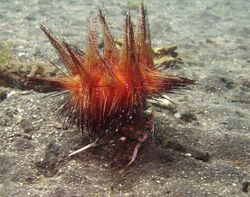Biology:Dorippe frascone
| Dorippe frascone | |
|---|---|

| |
| Dorippe frascone carrying a red radiant sea urchin (Astropyga radiata) | |
| Scientific classification | |
| Kingdom: | |
| Phylum: | |
| Subphylum: | |
| Class: | |
| Order: | |
| Infraorder: | |
| Family: | |
| Genus: | Dorippe
|
| Species: | D. frascone
|
| Binomial name | |
| Dorippe frascone (Herbst, 1785)[1]
| |
| Synonyms[1] | |
| |
Dorippe frascone, the urchin crab or carrier crab, is a small species of crab in the family Dorippidae that was first described scientifically by J.F.W. Herbst, in 1785. It is found in the Red Sea and parts of the western and eastern Indian Ocean. It often has a symbiotic relationship with a long-spined sea urchin and carries one around on its carapace.
Description
The urchin crab is a brownish-pink colour and grows to a length of about 5 cm (2 in). It has long-stalked eyes, a rounded carapace and long, slender legs. It uses only the first two pairs of legs for locomotion because the third and fourth pairs are used to grip a sea urchin which it carries around on its back. It is similar in morphology to the jellyfish crab (Ethusa spp.) but is easily distinguished by the different invertebrate transported. It also resembles decorator crabs[2] but those actually stick living creatures such as sponges, hydroids and bryozoans, bits of algae and inert objects to their shells.[3]
Distribution
Dorippe frascone is found in the Red Sea and off the coast of East Africa, including Mozambique and Cargados Carajos, an atoll north east of Mauritius.[1] [4]
Ecology
The urchin crab is so called because of its habit of carrying a sea urchin on its carapace.[5] This is usually the red urchin (Astropyga radiata), the black long-spined urchin (Diadema setosum) or the banded diadem urchin (Diadema savignyi). All these urchins have long, hollow spines and may provide protection to the crab by reducing the risk of predation by fish while not being too heavy to carry. The urchin obtains benefit by being transported to new feeding grounds. Even large and mobile individuals submit passively to being carried in this way.[2][5]
References
- ↑ 1.0 1.1 1.2 Davie, Peter (2012). "Dorippe frascone (Herbst, 1785)". WoRMS. World Register of Marine Species. http://www.marinespecies.org/aphia.php?p=taxdetails&id=209490.
- ↑ 2.0 2.1 Massimo Boyer. "Urchin crab". World Database of Marine Species. SeaDB. http://www.seadb.net/en_Urchin-crab-Dorippe-frascone_657.htm. Retrieved 2013-01-21.
- ↑ Hultgren, Kristin; Stachowicz, Jay (2011). "Camouflage in decorator crabs: integrating ecological, behavioural and evolutionary approaches". Animal Camouflage. Cambridge University Press. ISBN 978-0-521-19911-7. http://www-eve.ucdavis.edu/stachowicz/papers/Hultgren_Stachowicz_2011_BookChapter.pdf.
- ↑ Jonathan Bird. "Sea urchin crab". Jonathan Bird Productions. http://www.jonathanbird.net/browse/002647.htm. Retrieved 2013-01-22.
- ↑ 5.0 5.1 Maran, Vincent (2010-11-11). "Astropyga radiata (Leske, 1778)" (in French). DORIS. http://doris.ffessm.fr/fiche2.asp?fiche_numero=1846. Retrieved 2013-01-22.
External links
- Photos of Dorippe frascone on Sealife Collection
Wikidata ☰ Q5297873 entry
 |

